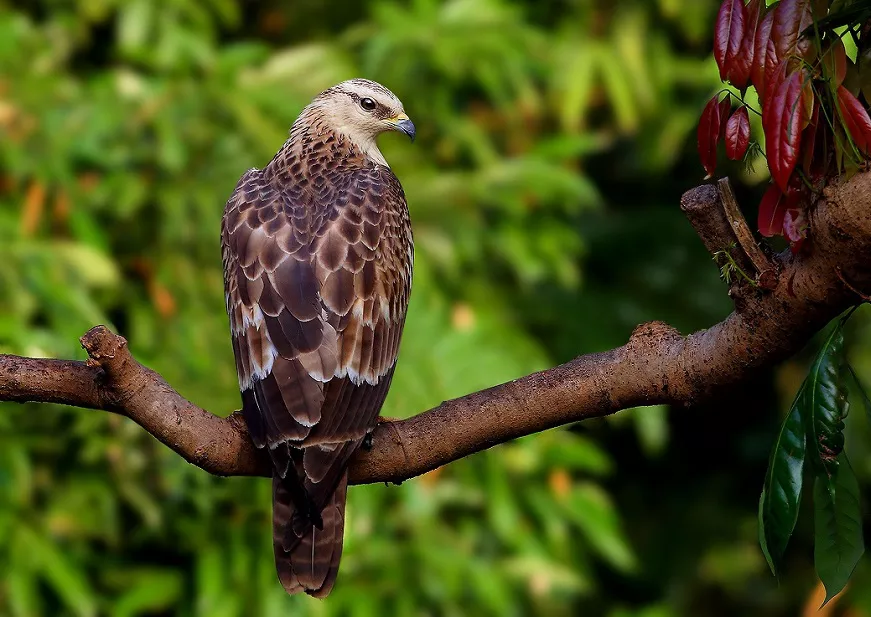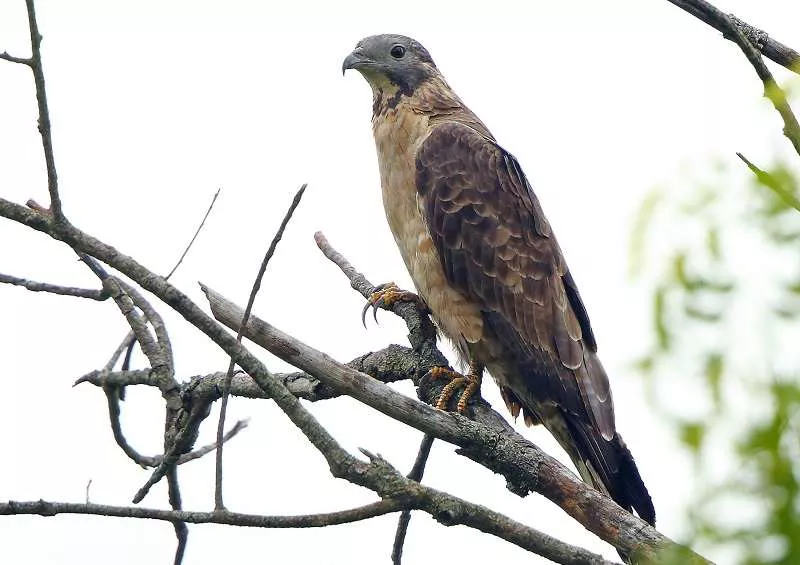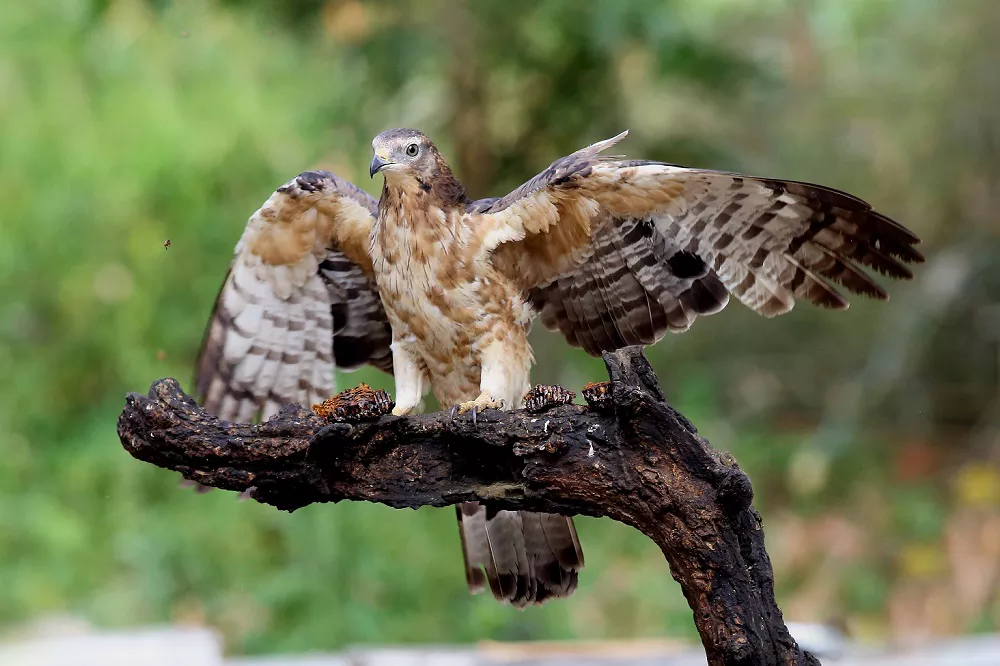The world of raptors is filled with diverse and fascinating species, each showcasing unique characteristics and adaptations. Two such avian wonders are the Crested Honey Buzzard (Pernis ptilorhynchus) and the Oriental Honey Buzzard (Pernis orientalis). While these birds share a similar ecological niche and a common interest in honey and honeycomb, they possess distinct features that set them apart. In this article, we delve into the differences between the Crested Honey Buzzard and the Oriental Honey Buzzard, shedding light on their appearances, habitats, and behaviors.
Taxonomy and Classification
The Crested Honey Buzzard and the Oriental Honey Buzzard belong to the same genus, Pernis, within the family Accipitridae, which includes eagles, hawks, and kites. However, their classification has been a subject of debate among ornithologists.
Crested Honey Buzzard:
Traditionally, the Crested Honey Buzzard is recognized as a distinct species. It is found across a wide range of habitats in South and Southeast Asia, including India, Sri Lanka, Myanmar, Thailand, and parts of China.
Oriental Honey Buzzard:
The Oriental Honey Buzzard, on the other hand, is sometimes considered a subspecies of the Crested Honey Buzzard, especially in older classifications. More recent studies, however, suggest that it deserves full species status. It primarily inhabits East Asia, including Japan, Korea, and parts of China and Russia.
Physical Appearance
One of the key differentiating factors between the Crested Honey Buzzard and the Oriental Honey Buzzard lies in their physical characteristics.
Crested Honey Buzzard:

Crested honey buzzard
The Crested Honey Buzzard is a medium-sized raptor with a distinctively crested head. This crest, composed of elongated feathers, gives the bird a unique and striking appearance. Its plumage exhibits a range of colors, typically varying from dark brown to pale grey. Adult males often feature a darker coloration, while females and juveniles tend to have lighter, more mottled plumage.
Oriental Honey Buzzard:
In contrast, the Oriental Honey Buzzard displays a more uniform appearance. It possesses a relatively long tail and broad wings, which aid in its soaring flight. The plumage of this species varies between individuals and populations, but it generally includes a mix of browns, grays, and rufous tones. In terms of size, the Oriental Honey Buzzard is slightly larger than its crested counterpart.
Behavior and Ecology
Diet and Feeding Habits
Both the Crested and Oriental Honey Buzzards are known for their specialized diets, primarily feeding on the larvae and nests of social bees and wasps, but their feeding behaviors and dietary preferences differ.
Crested Honey Buzzard:
The Crested Honey Buzzard feeds primarily on the larvae of social bees and wasps, especially during the breeding season. It possesses unique adaptations, such as specialized bill shape and leg length, which enable it to access the interiors of nests and extract the honeycombs. In addition to insects, this species also consumes small mammals, reptiles, amphibians, and occasionally, small birds.
Oriental Honey Buzzard:
The Oriental Honey Buzzard, as its name suggests, is highly specialized in its consumption of honey and honeycombs. However, its diet extends beyond just these sweet treats. It also preys on a variety of insects, including caterpillars, beetles, and other invertebrates. This species employs a unique technique known as “branch-hawking,” where it perches on a branch, scans the surroundings for prey, and swoops down to catch it.
Migration Patterns
Migration is another aspect where these two species show differences. Understanding their migratory behaviors provides insights into their adaptability and ecological roles.
Crested Honey Buzzard:
The Crested Honey Buzzard is partially migratory. Populations in northern regions, such as northern India and China, migrate to southern parts of their range during the winter months. This migration is influenced by seasonal availability of food resources.
Oriental Honey Buzzard:
The Oriental Honey Buzzard, on the other hand, undertakes more extensive migrations. Birds from northern parts of their range, including Russia and northern China, migrate to Southeast Asia and even Indonesia for the winter. This long-distance migration is a remarkable feat, highlighting their endurance and navigational abilities.
Habitat and Distribution:
Geographical Range
The geographical ranges of the Crested and Oriental Honey Buzzards overlap in some areas, but they also have distinct core habitats.
Crested Honey Buzzard:
The Crested Honey Buzzard inhabits a wide range of environments from dense forests to open woodlands and agricultural areas. It is most commonly found in the Indian subcontinent, Southeast Asia, and parts of East Asia. Its adaptability to different habitats has contributed to its relatively stable population.
Oriental Honey Buzzard:
The Oriental Honey Buzzard prefers more forested regions, particularly in East Asia. Its range extends from Japan and Korea through eastern China to the Russian Far East. During migration, it can be found in various parts of Southeast Asia, highlighting its ability to traverse diverse landscapes.
Reproductive Behavior
Nesting and Breeding
Both species exhibit fascinating nesting behaviors, which are crucial for the survival of their young.
Crested Honey Buzzard:
The Crested Honey Buzzard typically builds its nest high in the canopy of large trees. The nest is constructed from sticks and lined with leaves and other soft materials. The female lays 1-2 eggs, which are incubated for about 30-35 days. Both parents are involved in feeding and protecting the chicks until they fledge.
Oriental Honey Buzzard:

Oriental Honey Buzzard
The Oriental Honey Buzzard also nests in trees but tends to prefer more secluded forested areas. Its nest construction and breeding cycle are similar to those of the Crested Honey Buzzard. However, the Oriental Honey Buzzard’s nesting sites are often more difficult to locate due to its preference for dense cover.
Conservation Status
Threats and Conservation Efforts
Understanding the conservation status of these species is vital for their protection and the preservation of biodiversity.
Crested Honey Buzzard:
The Crested Honey Buzzard is currently listed as Least Concern by the IUCN, indicating that it is not immediately threatened. However, habitat destruction, particularly deforestation, poses a significant risk. Conservation efforts focus on habitat preservation and reducing human-wildlife conflicts.
Oriental Honey Buzzard:
The Oriental Honey Buzzard faces similar threats, with habitat loss being a major concern. It is also listed as Least Concern, but certain populations are declining due to rapid deforestation and agricultural expansion. Conservation initiatives aim to protect forest habitats and raise awareness about the species’ ecological importance.
Human Interaction and Cultural Significance
In Local Cultures
Both the Crested and Oriental Honey Buzzards hold cultural significance in various regions.
Crested Honey Buzzard:
In some parts of India, the Crested Honey Buzzard is considered a symbol of vigilance and keen eyesight. It is often depicted in local art and folklore. Farmers sometimes welcome these birds for their role in controlling pest populations.
Oriental Honey Buzzard:
In Japan, the Oriental Honey Buzzard is admired for its elegance and is sometimes featured in traditional paintings and literature. It is also associated with festivals that celebrate the natural world and the changing seasons.
Differences in Vocalization
Communication Through Calls
Raptors are known for their distinctive calls, which play a crucial role in communication.
Crested Honey Buzzard:
The Crested Honey Buzzard has a variety of calls, including a high-pitched whistle and a series of short, sharp notes. These vocalizations are used during mating displays and to communicate with chicks.
Oriental Honey Buzzard:
The Oriental Honey Buzzard’s calls are generally softer and less varied. It produces a series of low, mellow whistles, often heard during courtship and territorial disputes. These calls are less conspicuous, reflecting its preference for dense forest habitats.
Conclusion
The Crested Honey Buzzard and the Oriental Honey Buzzard, though similar in many respects, exhibit unique characteristics that make them fascinating subjects of study. From their distinct physical appearances and feeding behaviors to their migratory patterns and cultural significance, these birds exemplify the rich diversity of the natural world.
Related topics:



 Facebook
Facebook  Instagram
Instagram  Youtube
Youtube 